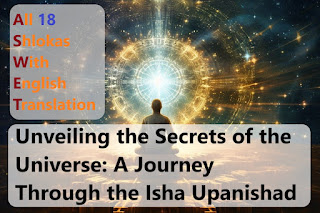Universal Vedanta। Introduction to Vedanta। Part 3 | Detail Understanding of Vedanta
Welcome back to my blog. Let me take an opportunity to continue the introduction of Vedanta for the foundation of upcoming episodes on different Upanishads. Links given below to read or listen previous articles or videos.
Second part from https://universal-vedanta.blogspot.com/2022/07/universal-vedanta-introduction-to.html or listen it at https://youtu.be/kLlaajXHE-s.
First part from https://universal-vedanta.blogspot.com/2022/07/introduction-to-vedanta-part-1.html or listen it at https://youtu.be/bXji-nbAWy4.
In my last article I mentioned there are 13 Mukhya or Principal Upanishads. They are –
1. Īśā Upanishad
2. Kena Upanishad
3. Kaṭha Upanishad
4. Praṣna Upanishad
5. Muṇḍaka Upanishad
6. Māṇḍūkya Upanishad
7. Taittirīya Upanishad
8. Aitareya Upanishad
9. Chāndogya Upanishad
10. Bṛhadāraṇyaka Upanishad
11. Śvetāśvatara Upanishad
12. Kauṣītaki Upanishad
13. Maitrāyaṇīya Upanishad
There are mainly 3 schools of thought that emerged based on Upanishads.
In modern days, a new school of thought emerged namely neo-vedanta school of thoughts. The teachings of Sri Ramakrishna and Swami Vivekananda was the foundation of this school initially. Later Sri Aurobindo, Sri Raman Maharshi, Radhkrishnan and other Indian and western philosophers contributed their thoughts to groom this modern school. This school of thoughts is mainly based on Advaita Vedanta but at the same time they accept and respect other schools. They talk about universal Vedanta, universal truth, inclusivity, acceptance of all schools, paths, and religion as true. They see Brahman or God as Nirguna or pure consciousness and Saguna or consciousness with certain characters both., They see Brahman or God as nirakara or formless and Sakara or with form both. The Self or living being can liberate themselves by practicing any or few or all the paths stated in Srimad Bhagavadgita. The paths are Gyanyoga or Knowledge, Karma Yoga or service without any desire, Bhakti Yoga or devotion and Raj yoga or meditation.
In the above pictures Brahman is shown as a fairy to make it understandable to readers. In reality Brahman is pure consciousness. It can not be shown in any form. The fairy is symbolic to Brahman. The same way Atman is also consciousness. In real sense it is formless and can not be displayed but as Atman always manifests in living beings, so, it is not a bad idea to show it as living beings.Dear readers, the subject is too vast like the ocean. I feel this little introduction is sufficient to jump to the actual subject. The next episodes will be on verses of different Upanishads. Be with me in this journey of Universal Vedanta movement. If you find any information incorrect in article, please let me know in the comment.
At the end, I will request you all to share this page and YouTube channel "Universal Vedanta" - https://www.youtube.com/channel/UCR9f52raAFQzWP9jK5U-FwA with your friends and families. Watch this message on YouTube in 3 languages.
Website: https://universal-vedanta.org/
Youtube: https://www.youtube.com/channel/UCR9f52raAFQzWP9jK5U-FwA











Comments
Post a Comment